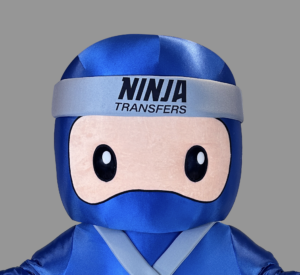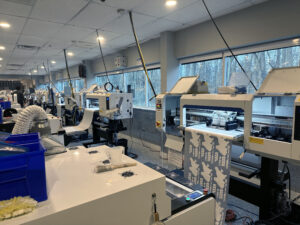In this installment from the Impressions “Ask the Experts” series, Impressions Content Director, Adam Cort, discusses the state of direct-to-film (DTF) technology and its implications for the decorated-apparel industry as a whole with, “Ninja Mike,” founder and CEO of custom heat-transfer specialist Ninja Transfers, based in Philadelphia, Pennsylvania.

Photo courtesy of Ninja Transfers
Adam Cort: To start out I wonder if you could give us a brief overview of Ninja Transfers, where the idea for the company was born and the specific niche, or niches, it fills as part of the broader decorated apparel industry. Also, I’ve got to ask, where did the Ninja mascot come from?
Mike: My team and I have worked for over a decade in the custom-apparel business doing e-commerce, screen printing, embroidery and DTG (direct-to-garment). When the pandemic hit, we figured it would be the perfect time to test new technologies to provide the best possible quality and service to our customers, and when we first got our hands on some DTF (direct-to-film) samples, we knew we could take it to a new level to displace DTG entirely.
After testing countless combinations of ink, film, powder, heating temperatures, curing time and pressing time, we found our winning formula. While it started with us printing our own transfers to decorate apparel for our customers, we realized we could use the transfers we’d mastered to help other decorators and businesses nationally to leverage DTF to grow or start their own business. Our customers range from huge regional print shops to individuals starting a side hustle and crafters. We’re proud to be able to provide our signature speed, quality and service to customers of all sizes and niches.
As for the Ninja mascot, I was hiking in the foothills of Mt. Fuji on an outdoor expedition, and our guide regaled us with stories of the great ninja clans of old Japan. After setting up camp for the night, we enjoyed a cup of tea and returned to our tents. That’s when it came to me in a dream: a ninja, clad in all blue, whose life goal was to provide premium DTF transfers to the masses. A beautiful sight, indeed!
AC: Decorating technologies seem to be changing at an ever-increasing rate these days, with DTF in many ways in the vanguard. How do you see DTF in general and custom transfers, in particular, working for newcomers to the industry or those looking to grow an existing business? How can custom transfers complement, say, a screen-printing or embroidery shop? Can newcomers launch a decorating business leveraging DTF and custom transfers alone?

A ganged sheet with multiple heat transfers unspools from one of a battery of DTF printers at the Ninja Transfers production facility. Photo courtesy of Ninja Transfers
M: The apparel printing industry is definitely changing at a rapid rate, now more than ever with DTF. Screen printers are often limited to at least 10 shirts per screen color to justify the time and cost of burning screens. Under a certain quantity or with too many colors some projects simply aren’t profitable or worthwhile to print. With DTF transfers, they can take those orders and increase revenue by just ordering custom transfers, after which they can easily heat press the apparel without the cost or time of maintaining DTF printers. The same goes for embroidery shops as well.
As for newcomers, they can easily launch a decorating business by ordering custom transfers. I know this because of the way we’ve helped tens of thousands of customers streamline their business and make more money with us. Whether it’s a small or large custom-apparel shop or even an embroidery or sign shop that wants to offer printed products, DTF is a perfect option to say, yes, to every order profitably, even one-piece orders due to our gang sheets being so cost effective.
AC: What advice would you give apparel decorators looking to integrate custom transfers into their business? Are there any common mistakes you see a lot of decorators regularly making early on? Are there best practices in terms of ordering, applying or marketing that newcomers to the business should be aware of?
M: The best advice I can give decorators looking to use DTF to supplement their business is pretty simple: do it. The DTF transfers industry has simplified everything, because it works on every color, every material and with almost any design. There are virtually no limitations. No longer do they have to be concerned about ordering the wrong transfer for the job or the number of ink colors involved. We can legitimately make the right DTF transfer with the perfect formulation for every apparel or bag product you can press on.
As far as best practices, we provide everything you need to know about how to press and how to troubleshoot a bad press to ensure you get the perfect press on every garment. Once you get the hang of it, it’ll be smooth sailing from there. That being said, the biggest mistake I see is decorators going out and buying an expensive printer, which can be a pain to maintain if you don’t dedicate enough time to learning it. It’s best to start with transfers and grow into your own printer setup once you’re sure it has become a part of your business. When starting out, focus on getting orders pressed up and out the door, not on cost efficiency.
AC: What are the limits in terms of the amount of business a company can expect to be able to generate decorating hats, T-shirts and other types of apparel or merch using outsourced custom transfers of the kind produced by companies like Ninja Transfers? When does it make sense for shops to consider bringing the actual production of the transfers they use in-house, as opposed to outsourcing them? I’m thinking you’re in a great position to speak on this topic given how Ninja Transfers supplies consumables like ink, film and powders in addition to actual transfers.
M: In the custom apparel business, the sky is the limit, especially with the advent of DTF. Never before in apparel customization has there been a technology where the print works on everything. If you can sell it, then between screen printing and DTF transfers, you can execute profitably on the order.
Every business is different, so there’s no exact set of parameters to follow when deciding to switch over to doing production in-house. The barrier to entry in terms of cost and effort can be $20k to $40k, so having demand and learning how often you can use DTF is a must for those looking to make that leap. We’ve had customers start out buying our transfers and then purchasing our consumables as their business has grown so they can provide close to the same high-quality transfers. We always support them whether they use us or not as they make the transition to printing on their own. We’re happy for them, in fact!
AC: Finally, thoughts on the future of DTF and the use of custom transfers both for individual decorators and the industry as a whole?
M: If a business isn’t including DTF in its printing arsenal, then it’s likely they’re missing out on potential revenue and/or cost savings. Custom transfers allow customers to never have to say, no, to any job, regardless of quantities or color count.
There are so many scenarios where DTF is a great way to go. If it’s a 25 to 200-piece order, and it’s a full-color design that a screen-print shop does not want to spend the press time on, they can order DTF transfers and have a junior person press it on a heat press rather than have their best printer use valuable screen-press time. Once you get fast at pressing or add more heat presses to your shop, you can take on even larger orders. We have customers printing 1,000-piece orders with our DTF transfers. The uses are endless.
Another example would be for small orders. If you don’t have a DTG machine in your shop and you get a lot of requests for one to five-piece orders, you’re not going to screen print those. However, you could accept them, put them on a gang sheet and make $10 to $15 on each garment instead of having to say, no. Even if you have a DTG printer, they’re really only good for cotton garments, while with DTF works on everything, whether it be cotton, polyester, nylon, spandex, high visibility, hats, you name it.
Yet another example would be the use of DTF for all orders where a customer says they are missing a few pieces. In these cases, you can simply resolve the issue with DTF transfers rather than resetting the job on a screen-printing press or waiting for your printer to print the new pieces for you. You simply resolve the issue with a heat press.
To learn more about Ninja Transfers and its complete line of custom patches, blank apparel and DTF consumables in addition to its transfers, go to ninjatransfers.com. For more “Ask the Interviews” videos, hosted by Impressions Content Director Adam Cort, click here.





